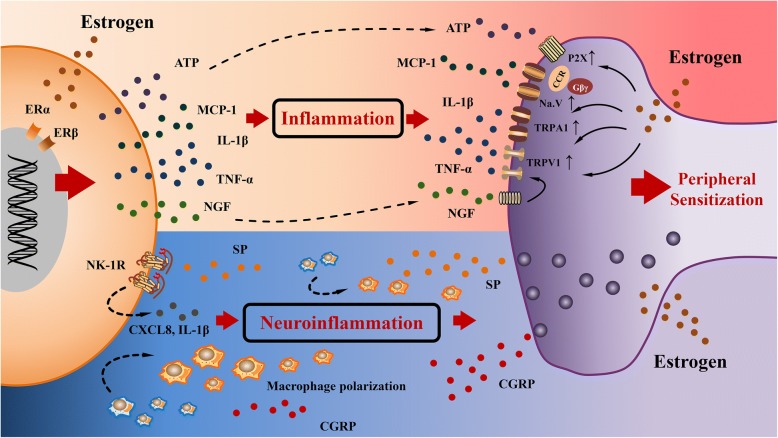Fig. 3.
Role of estrogen in inflammation in endometriosis. Estrogen not only stimulates the secretion of inflammatory cytokines from macrophages, but also upregulate the expression of nociceptors on nerve fibers. IL1β, MCP1 and TNFα from macrophage can activate TRPA1 and TRPV1 on peripheral nerves. NGF from macrophages can also activate TRPV1, resulting in cross-sensitization of the TRPA1 and TRPV1 receptors. The interaction of MCP1 and its receptor Na.V sensitizes nerve fiber through a CCR/Gβγ-dependent mechanism. Macrophage-derived ATP stimulates the action of nerve fiber via P2X purinoreceptor. Persistent stimulation of peripheral nerve can promote the secretion of inflammatory neurotransmitters from nerve fibers. Expression of SP and CGRP can be modulated by estrogen. Release of SP from nerve fibers activates its receptor NK1R on macrophages in response to estrogen, resulting in up-regulation of CXCL8 and IL1β form macrophage. The activity of SP and CGRP can also alter the polarization of macrophage toward M2 phenotype. Macrophage-derived inflammation and neurogenic inflammation are both regulated by estrogen inducing a vicious circle to aggravate peripheral sensitization
MCP1: monocyte chemoattractant protein 1; TNFα: tumor necrosis factor α; TRPA1: transient receptor potential cation channel, subfamily A, member 1; TRPV1: transient receptor potential vanilloid 1; SP: substance P; CGRP: calcitonin gene-related peptide; NK1R: neurokinin 1 receptor; CXCL8: chemokine (C-X-C motif) ligand 8.

